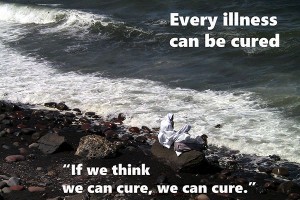 If we want to cure any illness, we need a clear definition of ‘cure’ for each and every type of illness. Then, we work to determine which type of illness we are attempting to cure, to define the process required for curing. Finally, we proceed to find the cure, using a process that checks and verifies itself as it proceeds. Let’s begin:
If we want to cure any illness, we need a clear definition of ‘cure’ for each and every type of illness. Then, we work to determine which type of illness we are attempting to cure, to define the process required for curing. Finally, we proceed to find the cure, using a process that checks and verifies itself as it proceeds. Let’s begin:
Step 1. Define CURE.
Cure: n. A cure is the end of an illness. ( Reference: 1)
Illness: n. An illness is a negative condition, consisting of a cause, which might be in the body, the mind, the spirit, or the community of the patient, and the consequences, signs and symptoms, which affect the body, the mind, the spirits and the communities of the patient.
There are three basic types of illness:
a. causal illness: the illness is active because the cause is active.
b. injury: the cause is gone.
c. blockage: where the illness consists of an inability to perform naturally healthy functions. A blockage might exist in the body, the mind, the spirits, or the community aspects of healthiness.
Cures: There are four distinct types of cures: curing, healing, transformation, and prevention. One for each type of illness and one more for good measure.
Types of Cures
1. Curing: bringing about the end of an active illness in the body, the mind, the spirits, or the community, by addressing the cause. Illness is the intersection of a cause and negative consequences, signs and symptoms of illness. It is cured when the cause has been successfully addressed. Corollary: The cause of an active illness has been successfully addressed when the illness is cured. If the cause reappears, an new illness might result – but not every instance of a cause results in illness.
A partial cure occurs when the cause of an illness is partially addressed, or when a single cause of a compound illness, with multiple causes, is addressed.
A temporary cure occurs when the cause of an illness is temporarily addressed. Temporary cures can lead to chronic illness if the cycle is repeated.
A chronic cure cures a chronic illness has a chronic cause, which can often be characterized as a habit. A chronic cure must not only address the cause, it must also address the chronic nature of the cause. Chronic illness often requires changing the habits of the patient, once the cause has been identified.
While an illness is not cured, it creates injuries.
2. Healing is an ongoing curative process that repairs injuries before, during, and after the illness. (Reference 2, 3, 4). An injury might come from an illness, or from an external event. Healing is seldom perfect.
Imperfect healing can lead to a blockage or a disability.
3. Transformation: Removing, and thus curing, blockages that reside in the body (physical), the mind (mental), the spirits (spiritual) or the community (communal and social). (Reference 4) Surgical cures are transformations. Most transformations are less severe: physical changes to body, changes to mental, spiritual, or community states cure blockages. Removal of blockage often necessitates healing.
A blockage that cannot be cured is a disability.
A disability is not an illness, because a disability is incurable. A disability is converted to a blockage by transformation, by curing it. A blockage is converted to a disability by giving up in attempts to cure, by accepting it as final.
4. Preventative cures address causes before illness can arise.
Note: When a cure is completed, no more medicines are required.
References:
- Webster’s: Cure: 3. “a complete or permanent solution or remedy.
- Oxford: Cure: 7. “A means of healing”.
- Stedman’s Medical Dictionary: 1. “To heal, to make well“
- Oxford: Cure II 4. “To treat surgically or medically, with the purpose of healing“
== End of Definition of CURE===
Step 2: Determine if the illness is a causal illness (has an active cause), an injury (the cause is gone) or a blockage (which might be transformed into an injury.
Step 3: If the illness is active, if it has an active cause, identify and address the cause.
If the illness is an injury, facilitate and aid healing.
If the illness is a blockage, attempt to transform it. This may result in an injury that can be healed.
Step 4: Test if the illness is cured.
The process for curing an illness is more complex in theory, and of course a lot more complex in practice. This image shows the theory of curing illnesses as a process flowchart.
Final note. Many ‘diseases’ actually consist of multiple active illnesses, with multiple causes. It is not possible to cure an illness consisting of multiple causes with a single cure – the illness can only be cured one cause at a time. This can be tedious and time consuming, but it is the only path to cure.
to your health, tracy
ps. Most medical dictionaries and medical reference texts do not define ‘cure’. As long as we ignore the concept of cures, we will remain ignorant of the cures that exist. Cure is a forbidden word in today’s practice of medicine.



